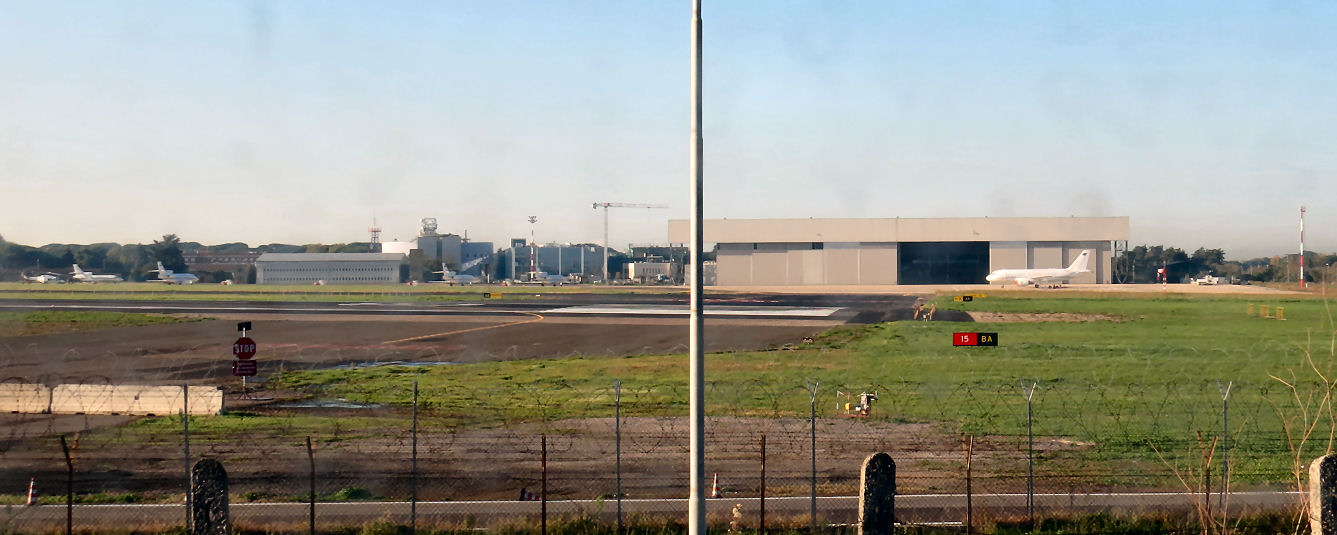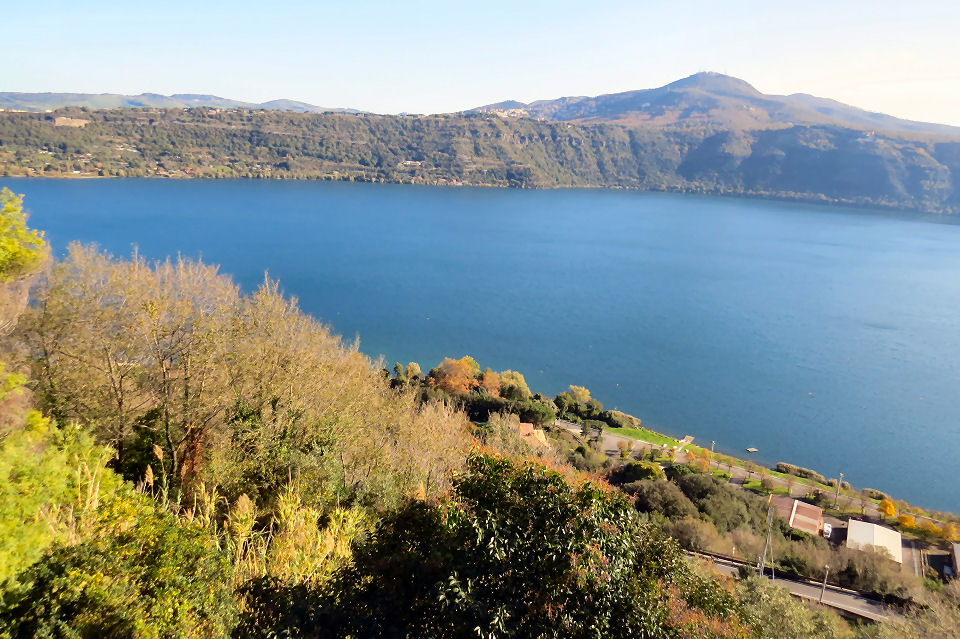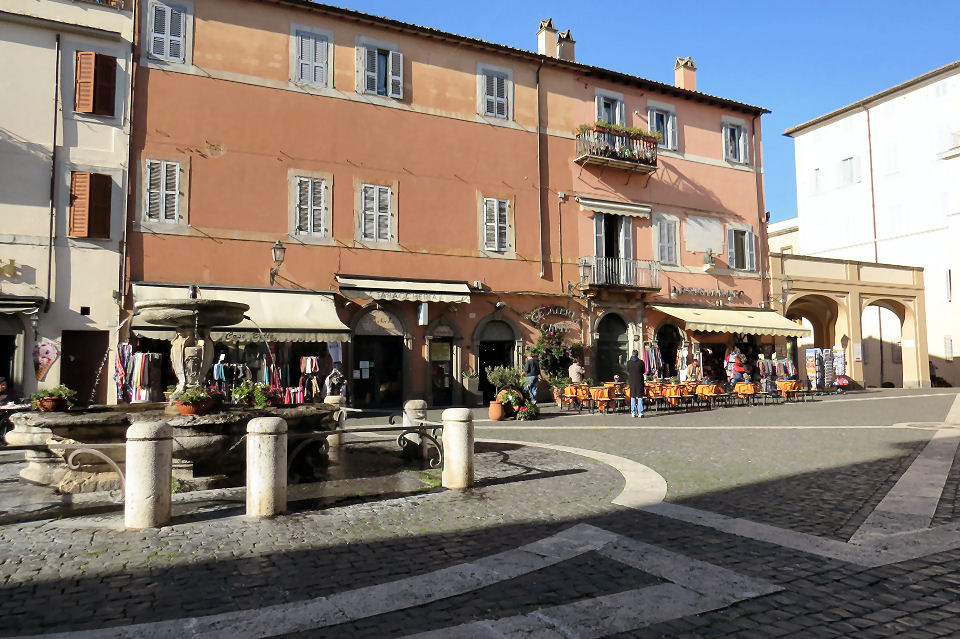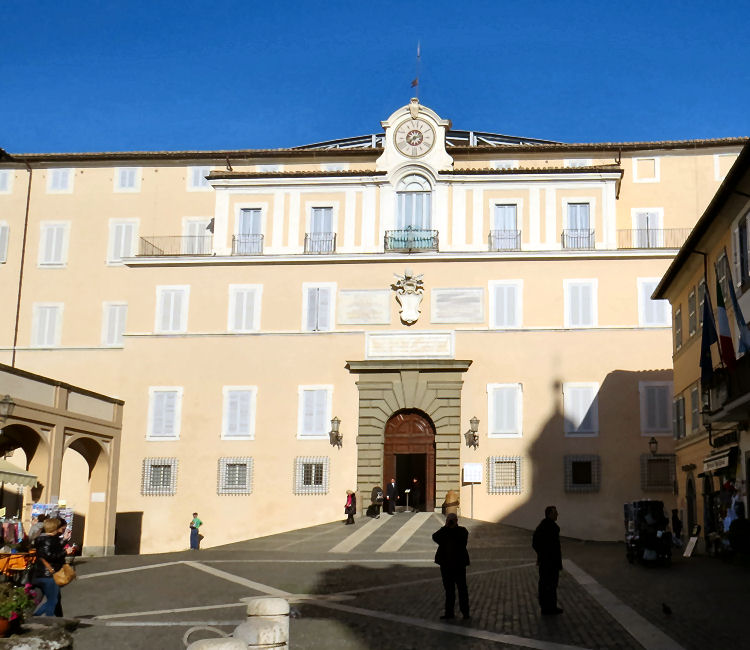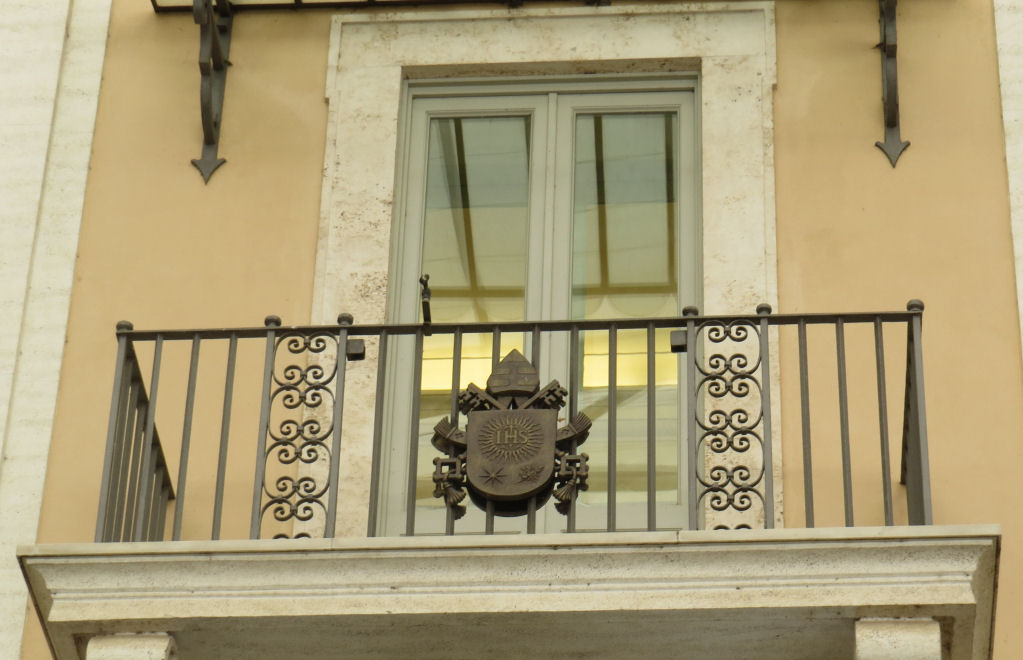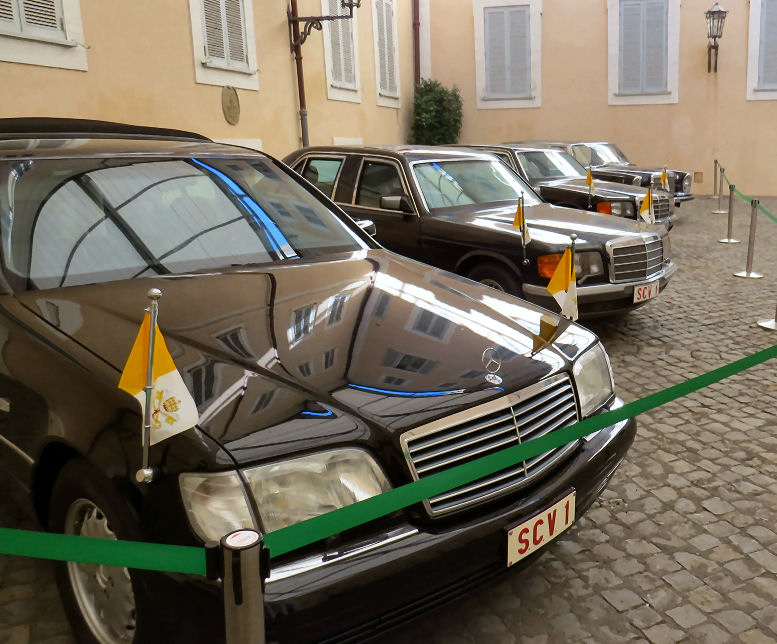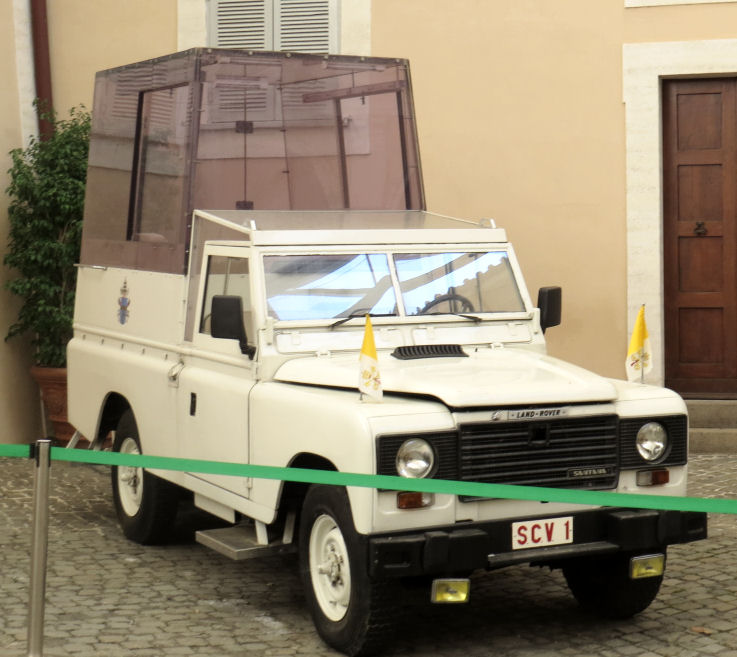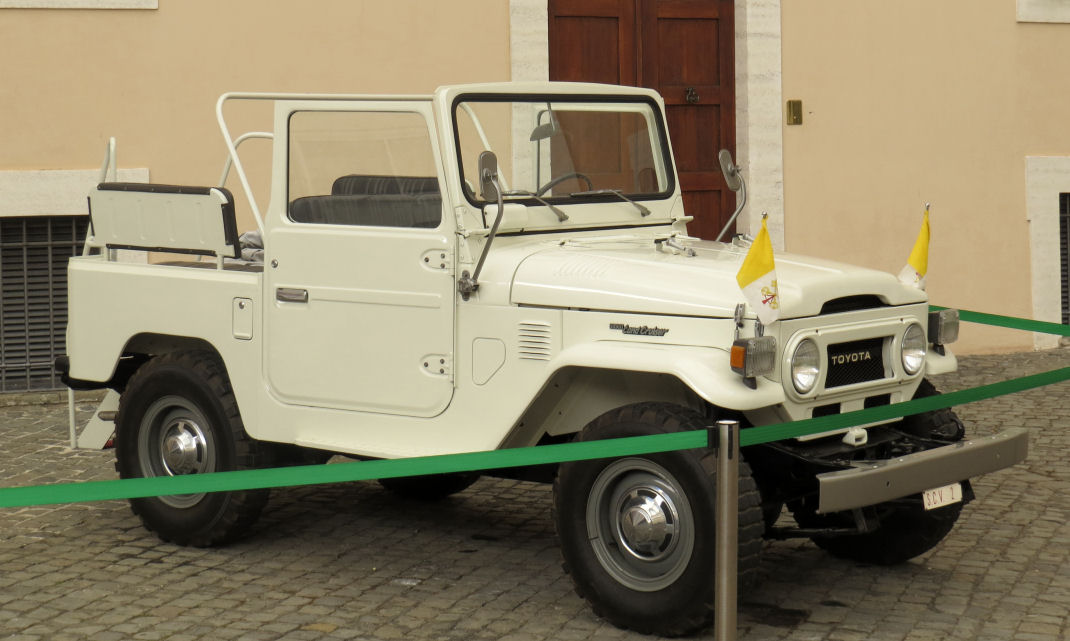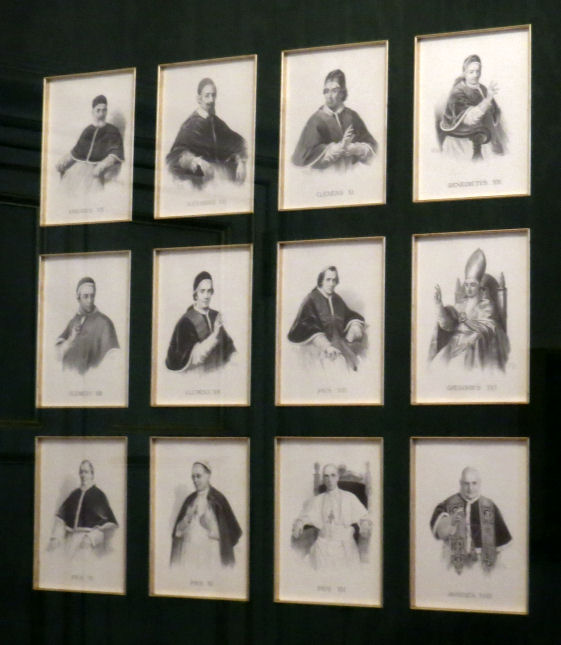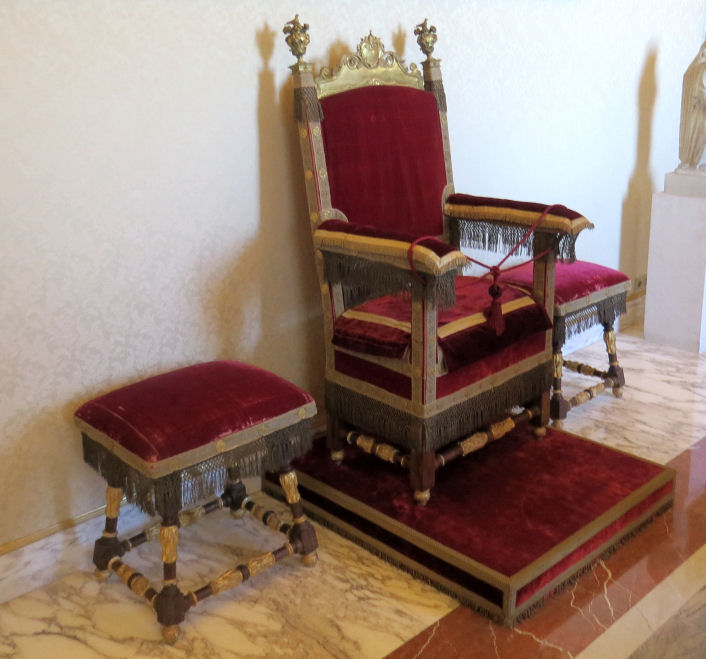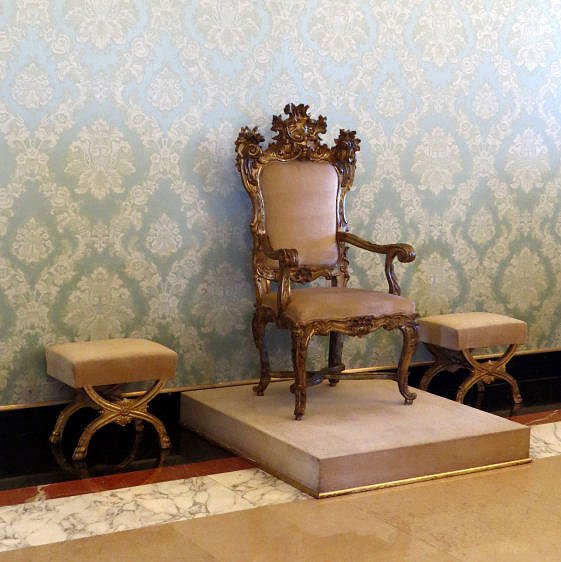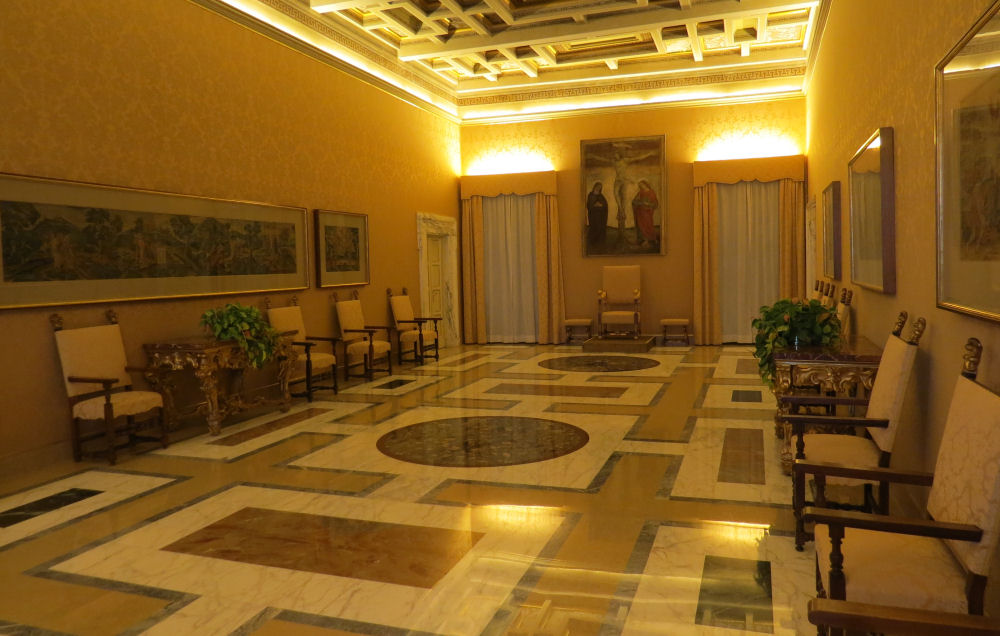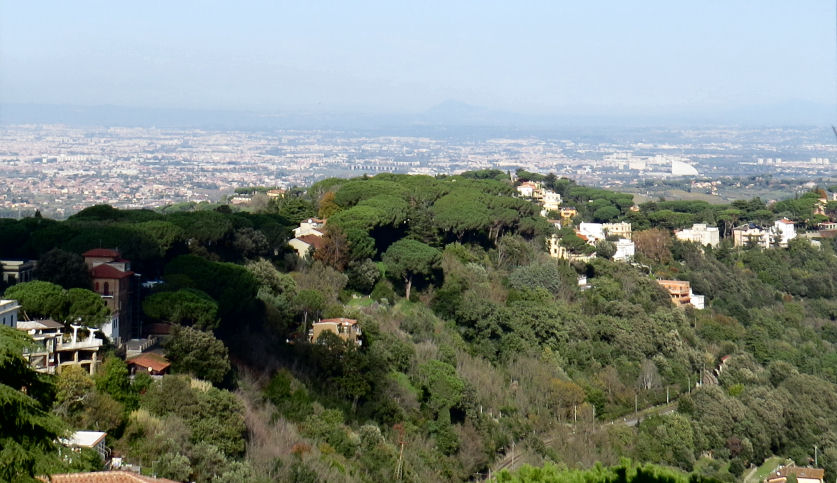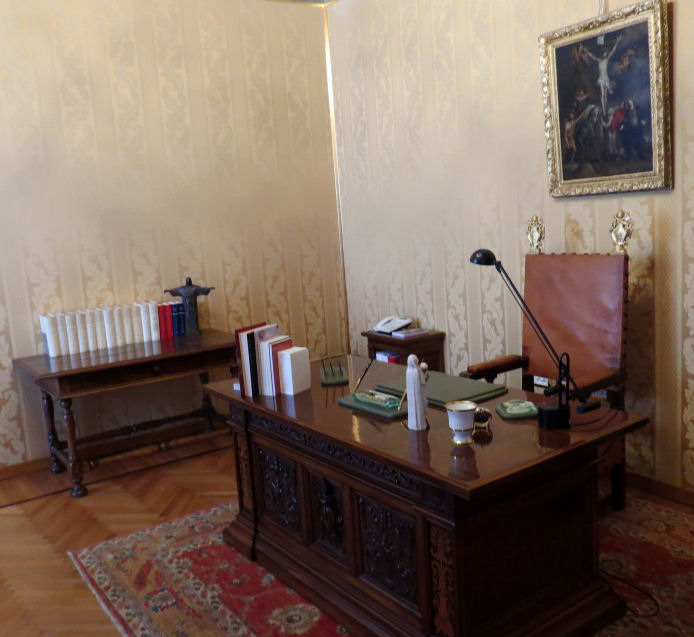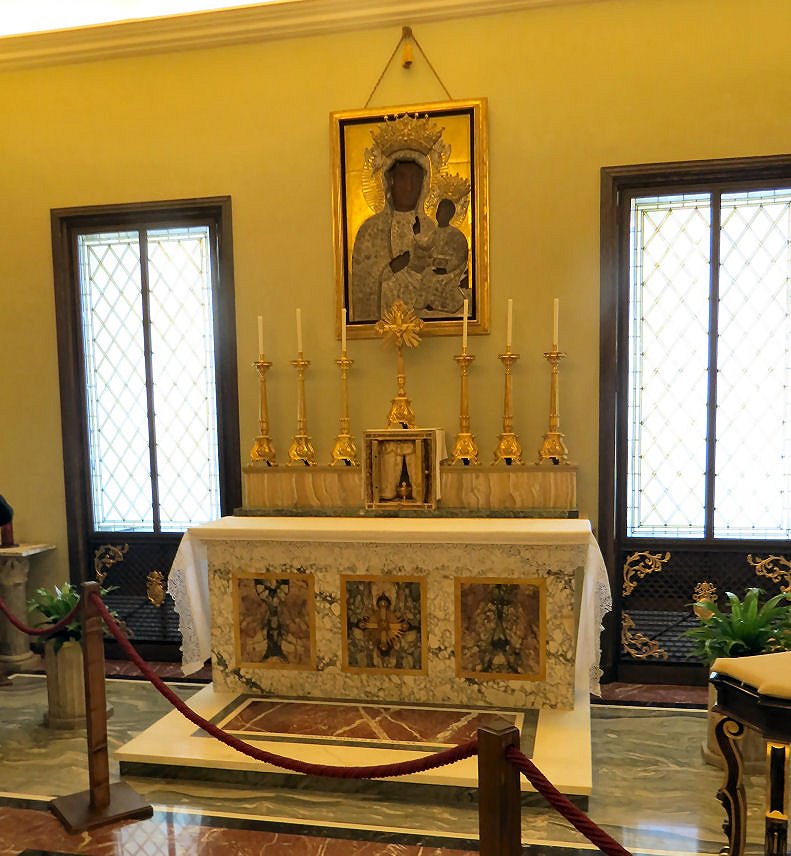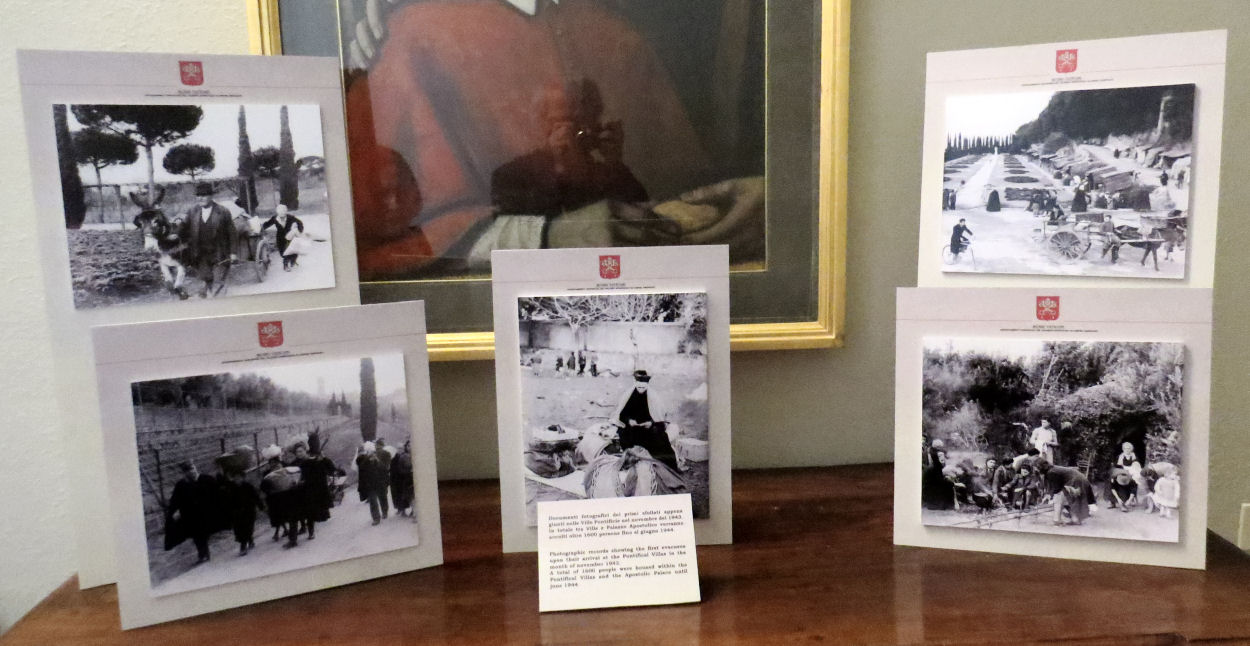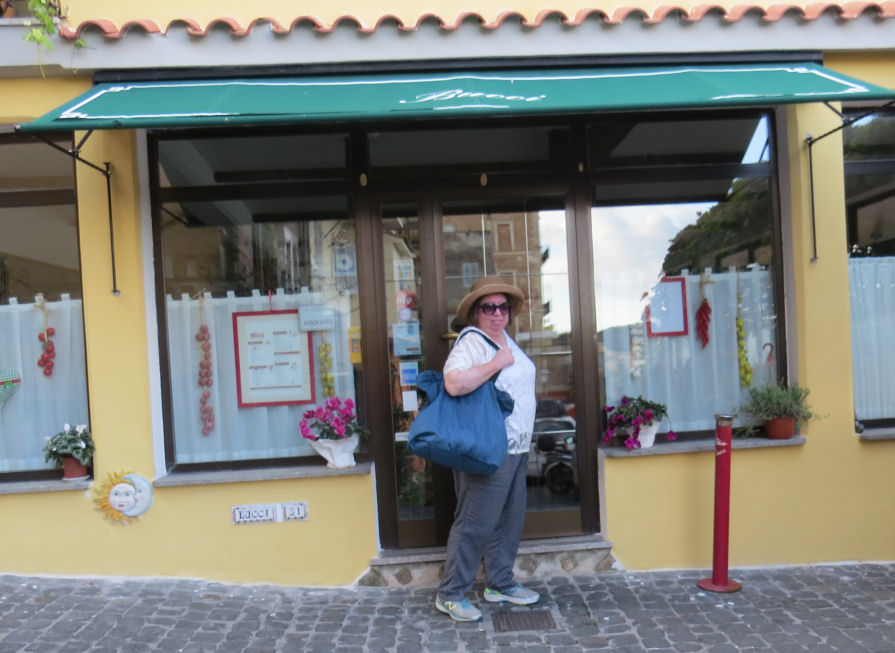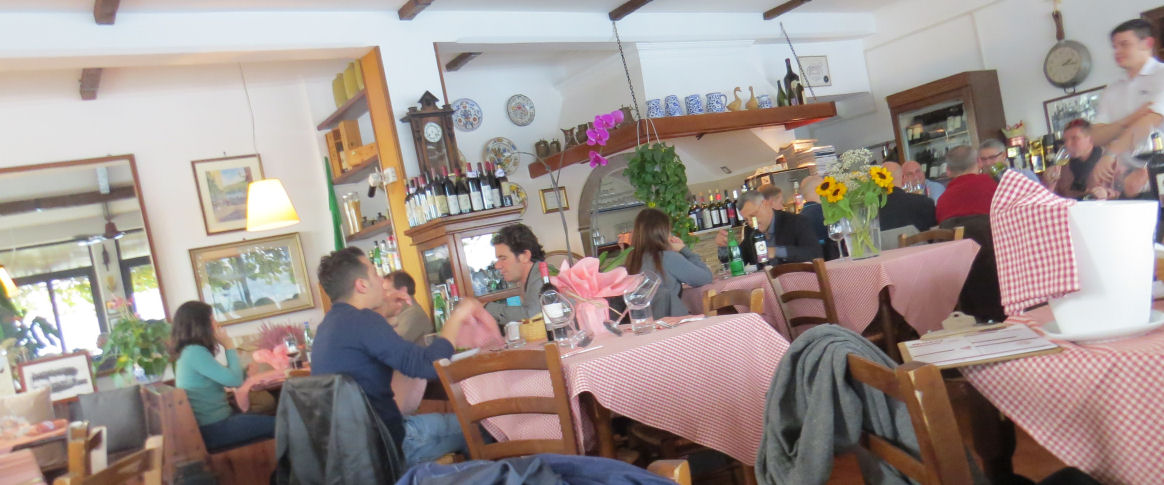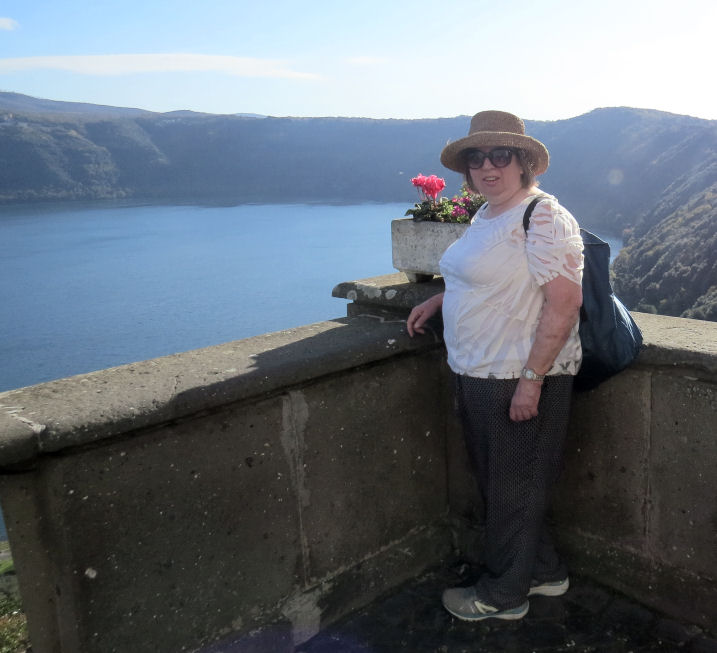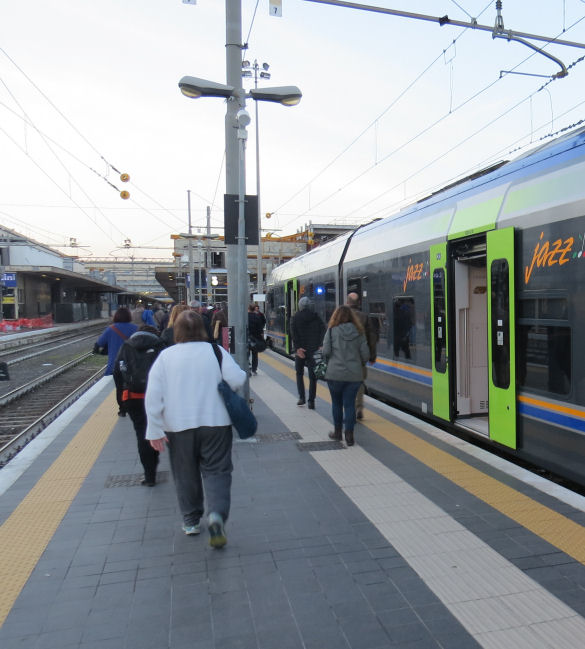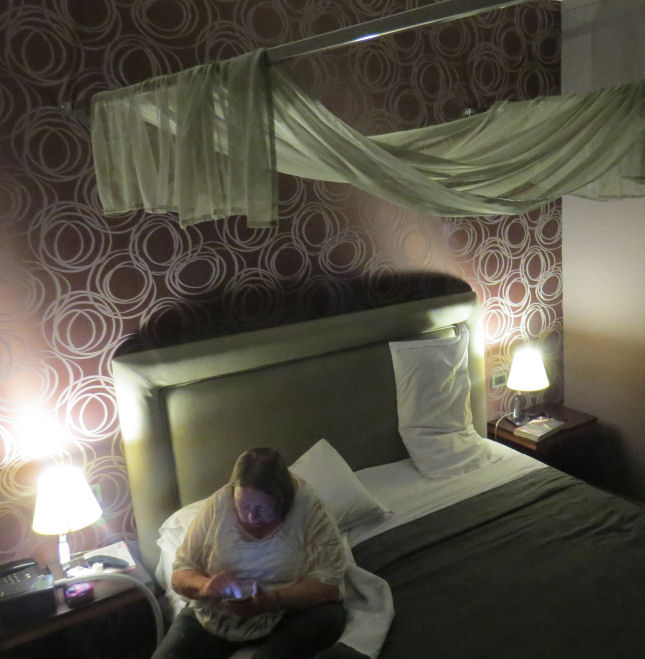I awoke on Monday morning at about six. I had been looking forward to this day for some time. At the end of 2015 at about the time that he declared the Jubilee Year of Mercy, Pope Francis announced that he planned to open the papal residence in Castel Gandolfo to the public.[1] He is the first pope since Pius XI[2] to decide to stay in Rome during the summer. Throughout the two-millennium history of the papacy the heat, stench, lack of sanitation, and prevalence of malaria-bearing mosquitoes constituted more than enough motivation to drive the pontiffs up to the Alban Hills during July and August. Air conditioning has evidently made it optional.
I was concerned about the walk from the train station to Castel Gandolfo. I kept telling myself that it must be possible for people with mobility impairments to get up to town, but the evidence in the Internet supporting this view was pretty flimsy.
Sue and I went down to breakfast at 7:40, ten minutes after the hotel's breakfast area opened for business. The bacon and sausages were cold. I wondered when they had been cooked.
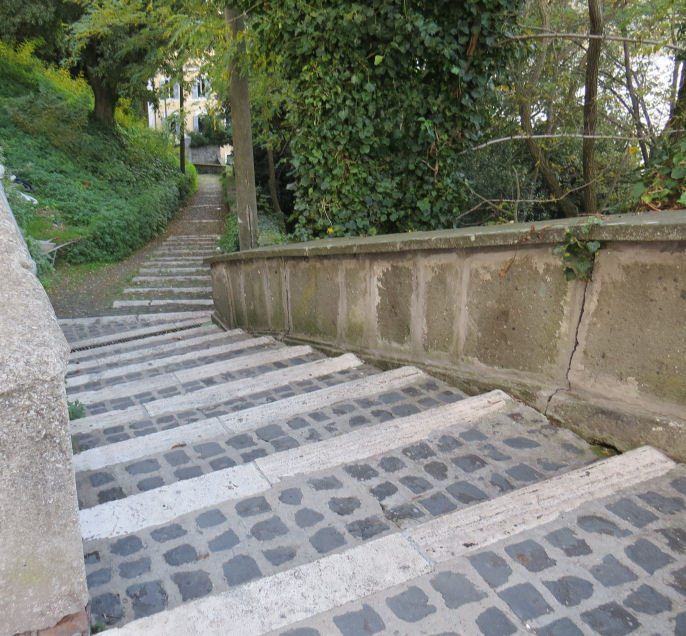
After breakfast I checked my e-mail on Sue's laptop. I then tried to turn it off, but it refused to power down using the usual buttons and menu options. I eventually held down the power key for ten seconds. We had to hope that nothing was seriously wrong with it.
We walked to Termini with our tickets in hand. Our train was not yet listed on the electronic schedule boards. After a few minutes I saw Albano Lazio appear at 9:21, the time that we expected to leave. Sure enough, one of the last stops listed for that train was Castel Gandolfo. After another ten or fifteen minutes the track number, 22, was posted. We went to one of the time-stamping machines to “convalidate” our tickets.[3] We then found seats on a comfortable train that was not very crowded.
A very nice conductor checked our tickets and showed us on his iPad how many stops remained until Castel Gandolfo. We memorized the last of these, Marino Laziale. It was unnecessary. All of the stops were announced quite clearly over the intercom.
One of the first stations was near Rome's other airport, Ciampino. Ryan Air flies to many European destinations from this airport. Nevertheless, only a few people boarded our train there.
We shared our car with a half-dozen or so youngsters who were perhaps of middle-school age. They and quite a few other people descended from the train in Castel Gandolfo at the same that we did. The station was obviously closed and uninhabited. There were no cabs waiting for passengers. In fact, the whole area seemed lifeless.
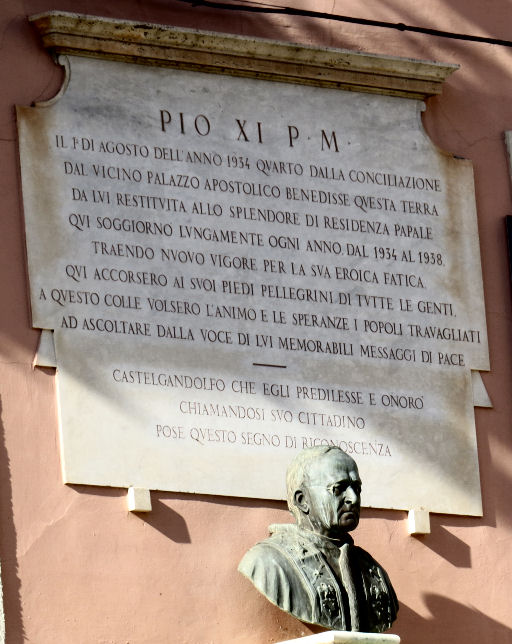
The kids immediately climbed the stairs to street level and began walking in a determined fashion uphill on the road. As the road curved to the left they crossed the street and ascended a few stairs to the paved path that I presumed was the Via Stazione. Everyone followed them, but before long the kids disappeared from view. Not long afterwards the adults were also no longer visible. We walked slowly and took a handful of breaks. If the path had been longer—as, for example, the exit from Plitvice Lakes—I am not sure that Sue could have made it. But she soldiered on, and we arrived in the middle of the town at about 10:30. The sun was shining brightly, but it was a little chilly, especially in the shade.
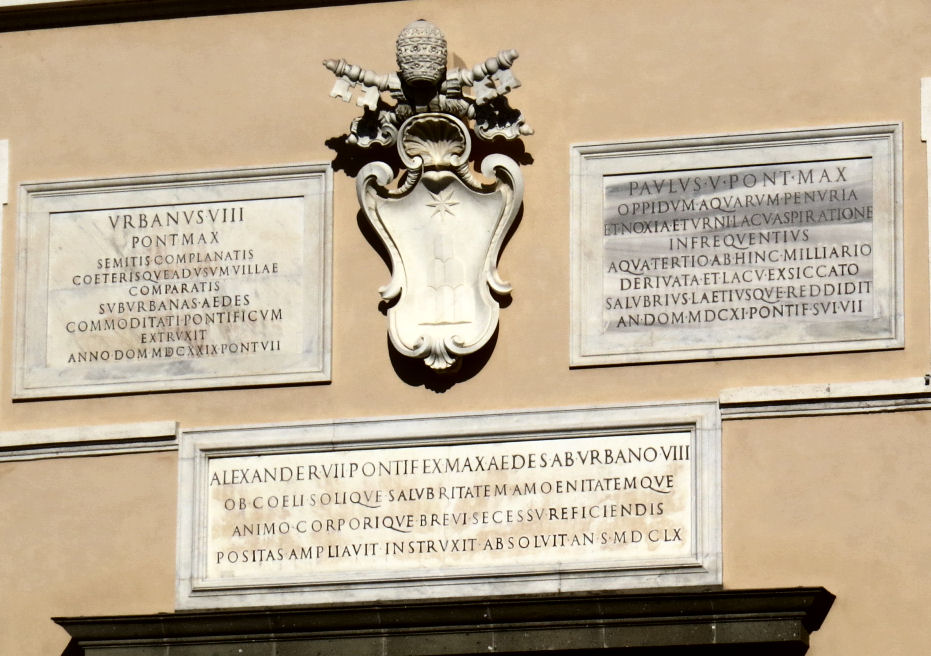
Sue discovered that the stitching in one area of her new Rick Steves day pack had come undone. We found an unoccupied bench in the Piazza della Libertà, and I guarded her stuff while she ambled over to one of the few open shops to try to purchase a needle and some thread. She found both readily enough. While she was mending her pack, I sought out a bancomat. I found one sponsored by Banco di Roma. The rate was much more favorable that the one that I located at Termini. I extracted €400, which I figured would last us through most of the trip.
The main entrance to the papal residence had been converted into the exit from the museum. A gentleman whose primary job was to direct visitors around to the side of the building was standing there when we arrived and was still there when we departed the papal residence.
I expected the operation of this museum to be similar to the process at the Galleria Borghese. In both cases the tickets were appointments for entrances at a specific time—every hour on the hour. The manner in which we exchanged our vouchers for tickets was, in fact, almost identical. That, however, was the end of the similarity. In this case we were provided with complimentary audio guides (in English) and pamphlets (in Italian) that described the rooms that were open to the public. In addition, we were not required to wait until the time of our appointment. There was no elaborate procedure for checking luggage and other items. We walked right in. The entire experience was very relaxed. We were, for the most part, allowed to go at our own pace. Best of all, we were allowed to take as many photographs as we wished.
The first area encountered was the main courtyard where a few popemobiles were on display. No explanation was provided as to when or where the cars had been used. I was especially curious about a Toyota Land Cruiser. The indoor part of the museum consisted of a large Portrait Gallery[4] and a number of rooms in which the pontiffs had lived and conducted business. Visitors were free to spend as much time as they wanted in the former, but the latter was done as a tour.
For most people one pope is difficult to distinguish from any other, but I was quite interested in each portrait in the gallery and the commentary in the audio guide about the pontiff depicted. I soon joyfully discovered that the commentary was about the popes themselves rather than the artists. However, almost as soon as we arrived, a gentleman announced that someone was leading a tour of the residence and he indicated whom we should follow. Almost everyone who was in the Portrait Gallery at the time came with us.
The tour was “guided” in the sense that an employee of the museum led us through the rooms at a rather slow pace. A second employee tagged along in the rear of the small crowd. No one got ahead of one or behind the other. No one pointed out which cunning plots had been hatched in which room.
I took a lot of photographs, but not many notes. I listened to the audio guide, which pretty much covered the same material as the room-by-room descriptions in the pamphlet. The latter was rather easy to read. I only needed to consult my dictionary[5] once or twice. The overall effect of the tour was in no way stunning. The museum was in its first month. At that point nothing there brought it to life. The furniture does not look lived-in, and it was hard to visualize what the pope himself would be doing in any of the rooms.

Here is a list of the rooms in the order in which we went through them. I decided to use the Italian terms, mostly because Italian has many more names for types of rooms than English does.
1. Salone degli Svizzeri, a big room where the Swiss Guards received unofficial delegations and groups of pilgrims. I don't know whether they wore those silly uniforms here or not.
2. Sala dei Palafenieri, where more illustrious guests were greeted by the pontiff's “gentlemen.”
3. Sala dei Pontefici, which contained sketches of a dozen fairly recent popes.
4. Salottino Verde, the green room that served as a waiting area.
5. Salottino dell'Orologio, a room with a big old clock that served to keep the pope's meetings on schedule.
6. Sala del Trono, which contained the pope's throne and served for face-to-face meetings with luminaries. This room had a terrace with a splendid vista of the city of Rome, which was about twenty-four kilometers to the north-northwest.
7. Galleria della Musica was once used to receive vising musical artists who were there for concerts. It now featured the throne decorated by Algardi for the enigmatic Pope Innocent X.
8. Sala del Partecipante e Cappella di Papa Clemente XIII, a chapel where Pope Clement XIII was known to pray the rosary. Most of those prayers were probably about the Jesuits, who were under attack in the eighteenth century by all of the great colonial powers with Catholic rulers.
9. Sala del Concistoro, the room in which the consistory of cardinals met to conduct business. This was interesting, but I was also interested in where they ate and slept.
10. Biblioteca del Santo Padre was almost devoid of books, but there was at least a desk.
11. Studiolo del Santo Padre had another desk for the pontiff. I suspected that Pope Benedict XVI, who actually moved into this palace when he retired, spent a lot of time in one of these two rooms while he worked on his thee-volume biography, Jesus of Nazareth.
12. Ufficio del Segretario Particolare seved as the office of one of the pope's secretaries.
13. Ufficio del Segretario Aggiunto e del Cameriere Particolare di Sua Santita was used by another secretary and one of the pope's attendants.
14. Stanza da Letto del Papa, where most of the popes slept. Pope Pius XII also employed it to shield refugees from the Fascists and Nazis. Forty children were born here! They were lovingly referred to as “the pope's children.”
15. Cappella Privata del Santo Padre Dedicata alla Madonna di Czestochowa, a chapel containing a replica of a portrait of the Madonna of Czestochowa, given to Pope Pius XI.
16. Galleria di Alessandro VII was used as a nursery for the many children born here between 1943 and 1944.
One area that was not included in the tour was the swimming pool that Pope (now St.) John Paul II had installed. The paparazzi loved it. The pamphlet's map also showed a billiard room. The door to it must have been closed during the tour.
The tour of the rooms did not impress me much. It was like touring a second-rate palace, which, I suppose, pretty well describes what it was. On the other hand, I felt certain that some very interesting meetings had been held in those chambers over the centuries. The only one that was mentioned was that Pope Pius XII's nomination of Angelo Roncalli, the future Pope (now St.) John XXIII, to the cardinalate was approved in the Sala del Concistoro in 1953.
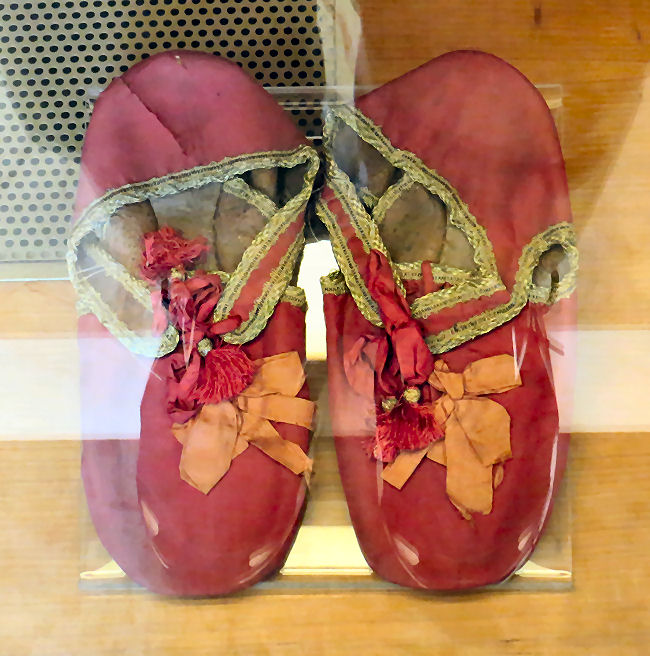
Maybe I am coming down too hard on the people who designed the museum. It had been open to the public for less than a month. A lot of work had obviously been required to accomplish as much as they had already done. The audio guides, in particular, worked fine, were in perfect English, and provided an amount of information that was fairly reasonable for the amount of time allotted.
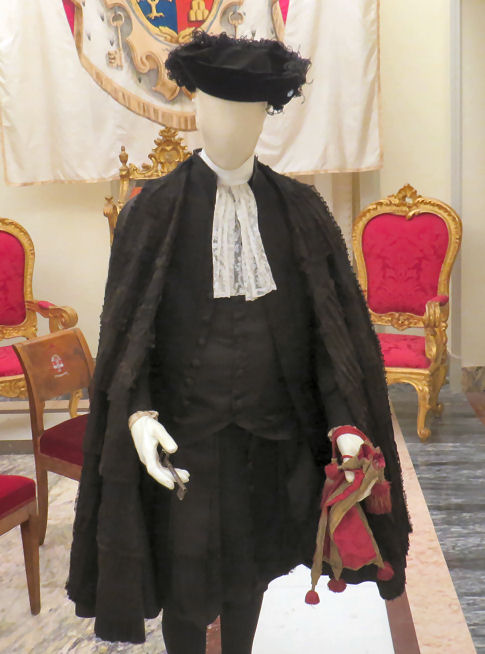
We finished our tour back in the Portrait Gallery, which contained paintings of all (or nearly all) of the pontiffs who had ever set foot in Castel Gandolfo. At first I was shocked to see Rafael's famous portrait of Leo X,[6] but closer inspection revealed it to be a copy.[7]
I listened to the audio guide's description of almost every pope. I knew that some of these guys were really rascals, and I wondered how candid the short biographies would be. The audio guide admitted the flaws of a few of them. Pope Paul IV's establishment of the ghetto for the Jews in Rome was, for example, termed “unfortunate,” which sort of implied that the Jews lost a lottery or some other game of chance. In fact, Paul IV was a hateful tyrant who did his best to destroy anyone who disagreed with him about anything. He despised the Spanish, devout and loyal Catholics for as long as anyone could remember, at least as much as he resented the Jews. Other popes were nearly as odious.
There were several other exhibits in the Portrait Gallery as well. Several pairs of papal slippers were on display. The uniform of the guy who carries the pope's symbolic keys around was displayed on a mannequin. I was particularly interested in the sedia gestitora that was on exhibit. It was surrounded by mannequins in various uniforms. Behind it were the fans that were used to cool the pontiff off. Never mind the guys who were toting him around on their shoulders. A collection of primitive-looking spears were hung on the wall. If their significance was explained, I missed it.
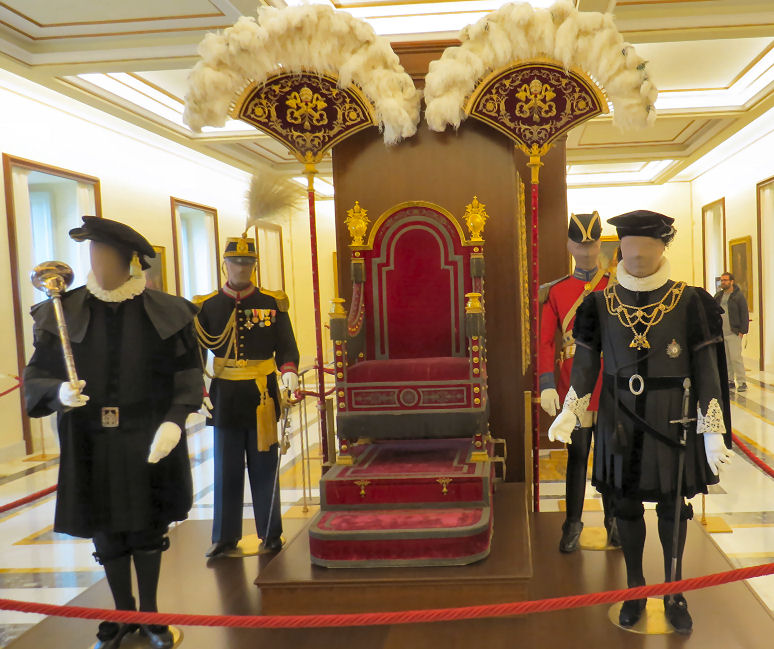
I really had a great time in the Portrait Gallery, but not every tourist is such a Pope-aholic. It took me several years of reading before I could keep the 266[8] pontiffs pretty well straight in my head. I think that I know how the presentation could be improved, but it would not be easy. The Church has never had much interested in teaching about the history of the papacy. Before I started researching, I could not have named three popes who died before I was born. The powers that be would probably be happy if the pontiffs were subjected to as little scrutiny as possible.
I took reasonably good photos of twenty-four of the papal portraits. These will appear on a separate page with a link here.
Note to all museums: Old people like Sue and me go to museums. We do not like to stand up for hours at a time. A few well placed chairs or benches would be greatly appreciated.
After we left the Palazzo Apostolico Sue went to some stores that sold ceramic tiles. I went looking for a place to eat lunch. I had read that there were many good places to dine in Castel Gandolfo, but this was off-season, and several of the establishments were closed. Castel Gandolfo is not a large place; it was easy to walk through all of its streets in less than ten minutes. I managed to locate one genuine restaurant named Bucci Ristorante. It was pretty much on the edge of the town and appeared to be filling up with locals. I rushed back to tell Sue about it.
Sue and I had a really enjoyable lunch there. I had lasagne with mushrooms and truffles and abbacchio (the Roman term for lamb). Both were absolutely delicious. We also shared a small bottle of Frascati Superiore, a white wine from Casale Marchese. The good food and wine and the nice atmosphere very pleasant experience. At first I regretted that it had not been warm enough to dine on the patio, which had a good view. Then I noticed tha smokers who repaired to that area several times during the course of their lunches.
The walk back to the train station was not nearly as bad as the climb had been. Sue's knees usually do not like downhill treks on uneven surfaces, but she did not seem to have much trouble with this one. Several people were already at the train station when we arrived. The station was obviously closed, but a sign on the side of the building specified two places in town in which one could buy tickets. There was also a train schedule. We had about a fifteen-minute wait for ours. We used the time-stamp machine to legitimize the tickets and found seats on a bench by the track.
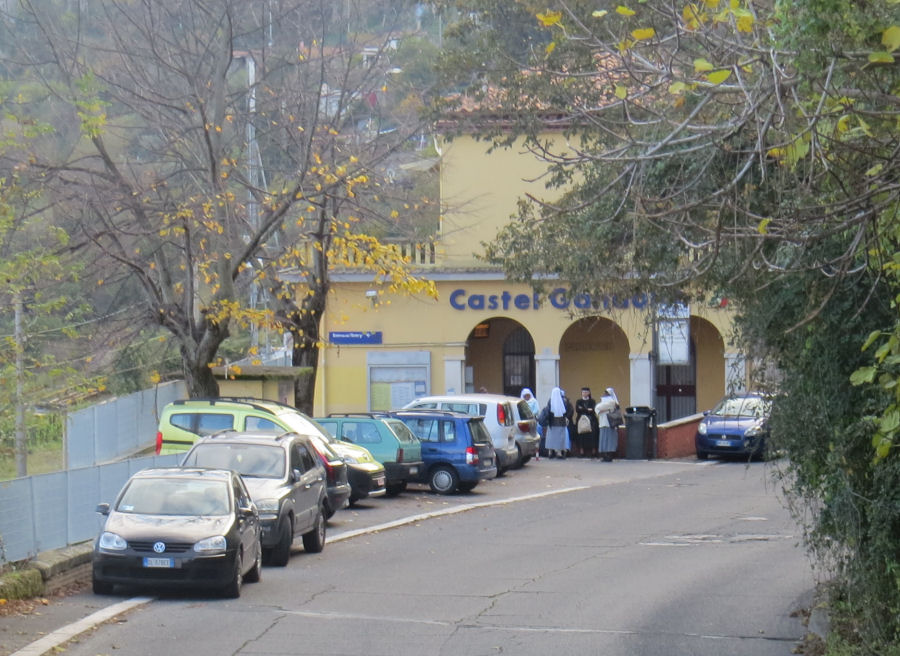
After a few minutes a young man approached us to ask where the door to the station was. We told him that the station was apparently not in operation, but, according to the sign, there were a couple of places in town that sold tickets. He made a sound of exasperation and went back upstairs to street level. We never saw him again. If I had been in his shoes, I probably would have tried to ride the train without a ticket. It would have worked; no one checked the tickets on the return journey. He might have been in trouble if a conductor had been present because I do not think that the conductor had the wherewithal to sell him a ticket.
The trains were equipped with closed circuit televisions that sometimes show the interior of the cars. I took a photo of Sue on the CCTV display.
A large number of people boarded the train at Fiumicino. The workers seemed to outnumber the travelers. By the time that the train reached Rome most of the seats were filled. I am not sure why it came to a halt a good distance from where we had boarded it that morning. We must have had to walk at least a quarter of a mile before we came to the part of the station that was open to the public. It was rush hour; thousands of people were departing from Rome; only a relative handful were arriving. It was hard to find a gate through which we could enter the terminal. We only saw one, and we had to ask the employee stationed there to open it for us.
We walked back to the hotel. Before we took the elevator up to the fourth floor, I went to the reception desk and paid for the room in cash. Sue arranged for a driver to pick us up at 7:30 on Tuesday for our 10 o'clock flight to Palermo.
I then napped for an hour or two. After that Sue and I depleted her remaining stores of food. I ate a nutrition bar and the last slice of pizza from Saturday's lunch. Sue had brought along two very small bottles of Sutter Home wine. I drank half of the red one.
I tried to sign on to the Internet. The computer booted up without a problem, but the WiFi connection was extremely slow. It was so bad that I could not even get my e-mail. I wasn't expecting anything important. So, I was probably only missing out on the chance to delete messages from the four or five low-cost online pet supply places that have strikingly similar websites and all offer flea protection for exactly the same price.
[1] The Villa Barberini Gardens, which were opened to the public in early 2016, for some reason can only be visited on Saturday. That made them impossible to fit into our schedule. I am not sure that I would have enjoyed spending two hours there anyway.
[2] From 1870-1929 the popes pretended to be prisoners in the Vatican. No pope ever left Vatican City during that entire period. In 1929 the Mussolini government and Pope Pius XI signed the Lateran Treaty that established the first relations between the Italian government and the papacy. The pontiff then modernized the papal residence in Castel Gandolfo. Every subsequent pope spent some time there.
[3] In Italy train tickets are not collected by conductors. In fact, in my experience the probability of a conductor checking the ticket is much less than 50%. Tickets that have not been time-stamped are considered invalid.
[4] I was never certain whether the rooms of the Portrait Gallery were used for this purpose before the residence was transformed into a museum.
[5] I have carried a rather large Italian-English dictionary with me on all of our tours of Italy. It has been quite useful enough times to justify its weight.


